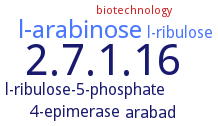2.7.1.16: ribulokinase
This is an abbreviated version!
For detailed information about ribulokinase, go to the full flat file.

Word Map on EC 2.7.1.16 
-
2.7.1.16
-
l-arabinose
-
l-ribulose
-
l-ribulose-5-phosphate
-
arabad
-
4-epimerase
-
biotechnology
- 2.7.1.16
- l-arabinose
- l-ribulose
-
l-ribulose-5-phosphate
-
arabad
-
4-epimerase
- biotechnology
Reaction
Synonyms
AraB, AraK, L-ribulokinase, ribulokinase (phosphorylating)
ECTree
Advanced search results
Cloned
Cloned on EC 2.7.1.16 - ribulokinase
Please wait a moment until all data is loaded. This message will disappear when all data is loaded.
expression in Corynebacterium glutamicum. Corynebacterium glutamicum is metabolically engineered to broaden its substrate utilization range to include L-arabinose. The resultant CRA1 recombinant strain expressed the Escherichia coli genes araA, araB, and araD encoding L-arabinose isomerase, L-ribulokinase, and L-ribulose-5-phosphate 4-epimerase, respectively, under the control of a constitutive promoter. Unlike the wild-type strain, CRA1 is able to grow on mineral salts medium containing L-arabinose as the sole carbon and energy source. The three cloned genes are expressed to the same levels whether cells are cultured in the presence of D-glucose or L-arabinose. Strain CRA1 is able to utilize L-arabinose as a substrate for organic acid production even in the presence of D-glucose
-
expression in Saccharomyces cerevisiae. Improvement of a bacterial L-arabinose utilization pathway consisting of L-arabinose isomerase from Bacillus subtilis and L-ribulokinase and L-ribulose-5-phosphate 4-epimerase from Escherichia coli after expression of the corresponding genes in Saccharomyces cerevisiae. These improvements make up a new starting point for the construction of more-efficient industrial L-arabinose-fermenting yeast strains by evolutionary engineering
-


 results (
results ( results (
results ( top
top





